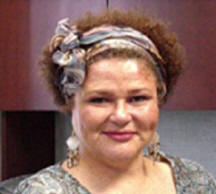Interview
with Lisa Delpit:
Discovering
Brilliance in Our Children
Nile Stanley
 Internationally known
scholar and writer, Dr. Lisa Delpit has focused her work primarily on the
education of children of color, particularly African-American. Perhaps her
most well-known book is Other People's Children:
Cultural Conflict in the Classroom (1995). The book documents and analyzes
how cultural conflict and mismatch occurs between white, middle-class
educators and African-American children. Included are essays on education in
Papua New Guinea in the South Pacific and Native Alaskan cultures. Recent
works on multicultural language strengths and differences within schools are
The Real Ebonics Debate: Power, Language, and the Education of
African-American Children (1998) and The Skin That We Speak: Thoughts
on Language and Culture in the Classroom (2002).
Internationally known
scholar and writer, Dr. Lisa Delpit has focused her work primarily on the
education of children of color, particularly African-American. Perhaps her
most well-known book is Other People's Children:
Cultural Conflict in the Classroom (1995). The book documents and analyzes
how cultural conflict and mismatch occurs between white, middle-class
educators and African-American children. Included are essays on education in
Papua New Guinea in the South Pacific and Native Alaskan cultures. Recent
works on multicultural language strengths and differences within schools are
The Real Ebonics Debate: Power, Language, and the Education of
African-American Children (1998) and The Skin That We Speak: Thoughts
on Language and Culture in the Classroom (2002).
Currently, she is the Executive Director of the Center for Urban Education
and Innovation at Florida International University in Miami. Major awards she
has received include the award for Outstanding Contribution to Education in
1993 from Harvard Graduate School of Education, which hailed her as a
"visionary scholar and woman of courage."
She received the 1994 American Education Research Association Cattell Award
for Outstanding Career Achievement. Here is a recent interview.
"If teachers make judgments only according to the tests being
inflicted on the children by the schools, then they can misunderstand their
children's brilliance."
Lisa
Delpit
Stanley: What is the focus of the Center for Urban Education
and Innovation?
Delpit: Our goal is to provide schools and communities with
the necessary skills to insure excellent education for low-income children of
color, particularly African-American.
Stanley: What is the greatest challenge for teachers
instructing urban children today?
Delpit: I think teachers must believe in their children’s
brilliance. If teachers make judgments only according to the tests being
inflicted on the children by the schools, then they can misunderstand their
children's brilliance. The biggest thing is that
despite what you have read or been told about these children that may indicate
otherwise, these children carry a brilliance that you have little access to.
You have to figure out how to bring that brilliance out. I don't
think we do a good enough job of showing teachers how to uncover the children's
strengths.
Stanley: Are their any strategies you recommend for
discovering children's brilliance?
Delpit: The biggest strategy I advocate is the arts. Teachers
who see their students engaged in the arts have an opportunity to see their
students in a different light, whereas before all they saw was what their
children couldn't do. The arts show you what
children can do. Another strategy is to talk to people who have an opportunity
to observe the children outside of school. Teachers should learn about the
children's community. For example, some children
might not be able to do a worksheet on money; yet the same children may take
major responsibility for interchanges with money.
Stanley: How can the arts empower language different
children?
Delpit: I can't think of anything
that would empower children more than the arts. I believe the rhythm and rhyme
of poetry appeals to all children, especially children of color and African
descent children. When you present another language in poetry and chants, the
children incorporate that language into their repertoire. It's
like being in the club. Once you are in the club you want to do all the things
being in the club entails. You become part of the English language club when
you begin knowing English poems and songs or knowing the words in an English
play. It opens your mind to learning so much more. I grew up in the Catholic
Church where the kids learned prayers very young. Even though the kids didn't
know what the prayers meant, they felt part of the church club very early.
Enjoying poetry makes you feel like you are in the club. You become a member
of the club and you want to engage in other aspects of the club. In learning
language, children need to learn how to represent it in different ways such as
physically or through drawing. The more aspects of themselves that they can
include in the learning, the better they will learn. If they can use their
bodies, their eyes, and their voices they will learn the language better. For
example I am trying to learn Spanish. One teacher focused on learning how to
conjugate verbs, and frankly I didn't learn much. On
the other hand, I had a teacher who had the students get up and do plays and
skits. These made the students speak Spanish in a meaningful context. I think
there is extreme potential in learning a second language in the context of the
arts.
Stanley: There have been legislation prohibiting second
language learners from speaking their native language in school and doing away
with bilingual programs. What is your reaction?
Delpit: My dissertation work was in New Guinea in isolated
villages. Those people needed a firm base in their own language before they
are exposed to a completely foreign language. You can learn two languages
concurrently if both those languages are supported in the home and the
community. However to learn a new language in a school fashion you need to
have previously developed the concepts in a language that is typically your
home language. This has been verified by the research of Jim Cummins and
others (see
http://www.iteachilearn.com/cummins/). The
earlier we move kids away from developing concepts first in their own language
the more we risk kids not learning complete concepts about phenomena. My
research was on children learning to read and doing math in their home
language first. The evaluation results of the programs were that those kids
learned to speak English faster when using their home language first. The
implications of my research suggested that children should only learn to read
once and that should be the language that they are most familiar with.
Stanley: What if the teachers you are working with decide to
use arts in the classroom, and then they go to their school and come back to
you in tears. They say that the principal won't let
them engage in arts in the classroom. The stated reason is only strategies
that have been validated by scientific research are allowed, such as the
National Reading Panel or the fab 5 of phonemic awareness, phonics,
vocabulary, fluency and comprehension? What do you suggest they do?
Delpit: I would talk to them about how they can use the arts
to teach those fab five. It's not really that hard.
I would show them that kids could have fun doing the arts and still learn
those skills. How they can deal with the principal is a hard call. They should
have initially thought out how to incorporate those skills through the arts.
They need to take the stance that they are teaching phonics through the arts.
The teacher might present the principal with five articles from the
professional literature supporting using the arts to teach reading skills.
Stanley: I believe that we must also teach from the heart.
What types of dispositions do teachers of second language learners need to
have?
Delpit: I have found from working with both pre-service and
practicing teachers, they have to be extremely open to their students. Their
hearts need to be open. They have to know how to observe and listen to their
students. More than just having strategies they need to find out about the
children and their parents. I call this ethnographic teaching. List all the
things that make it challenging to teach that child. Then your assignment is
to write down all the child's strengths. They need
to present as many strengths as problems. What they inevitably learn to do is
to change a child's problem into a strength. For
instance, take a child that does a lot of antics to make the class laugh.
Teachers can turn that child's challenge into a
strength. The child is viewed as having a lot of expression, acting ability,
and humor. Teachers can create a curriculum based on strengths rather than
weaknesses, then they are teaching to their student's
needs.
References
Delpit, L.D. (1995). Other people's children:
Cultural conflict in the classroom. New York: New Press.
Perry, T., & Delpit, L. D. (1998). The real ebonics debate: Power,
language, and the education of African-American children. Boston: Beacon
Press.
Delpit, L.D., & Dowdy, J.K. (Eds.). (2002). The skin that we speak:
Thoughts on language and
culture in the classroom. New York: New Press


